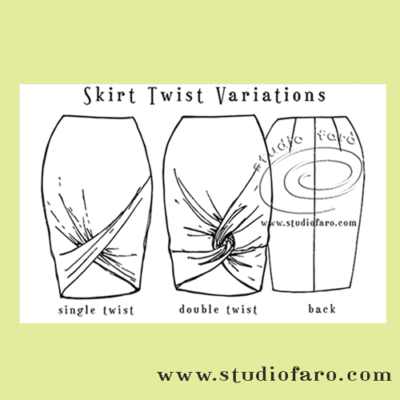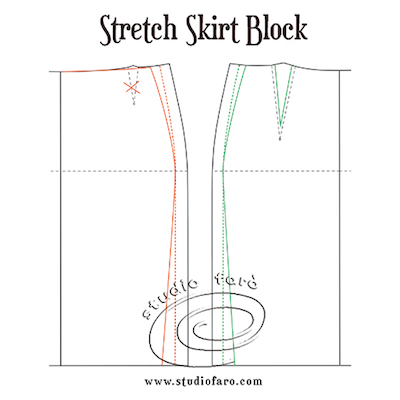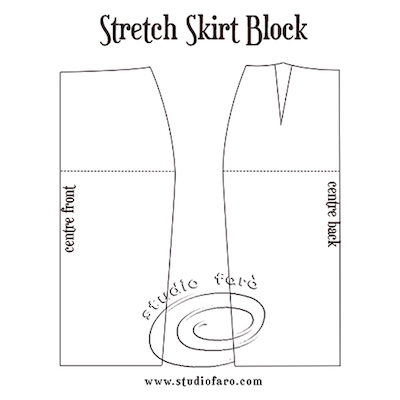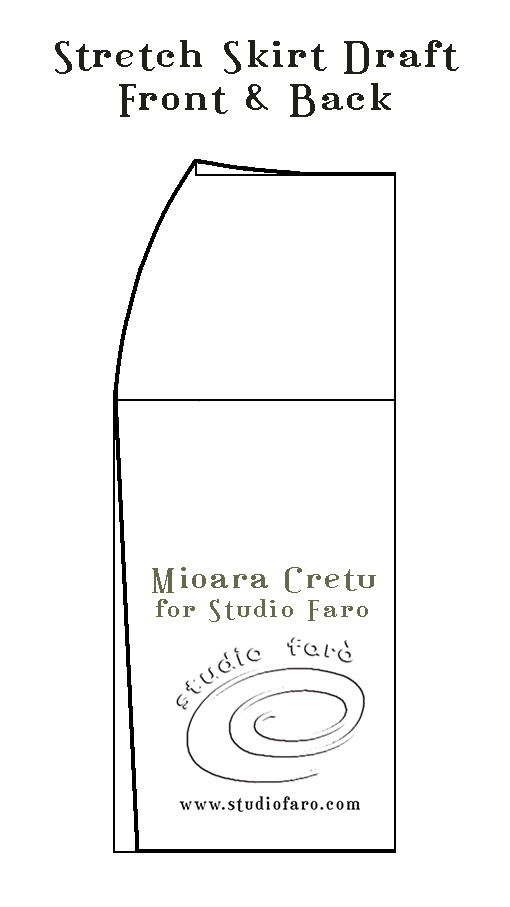25 Aug Stretch Skirt Block
Posted at 13:38h
in Garment Blocks, Pattern Making Instructions, Pattern Puzzles, Stretch Patterns, Womens Skirt Block
0 Comments
This is the very first of my Pattern Fundamentals that will occasionally interrupt the regular #PatternPuzzles. We are hoping to give you all the opportunity to prepare the necessary blocks to make better use of our Pattern Making instructions on the blog.

A number of our blog posts use a Stretch Skirt Block as a starting point for new styles. What we will do in this post is provide the instructions for you to prepare this block for your own individual-fit patterns.
We start with my Basic Skirt Block. The fit of this block is for woven fabric and usually has an addition to your hip measurement of garment ease (+4cm). The Stretch Skirt Block we are making has negative ease. That is, we cut the fit of the skirt smaller than our hip measurement to utilise the stretch (elastane) in the fabric. Each knit has a slightly different requirement in negative ease. In this case I will be using a ponti as my test fabric. My approach would be to select skirt block two sizes smaller than I usually use and make a few modifications. This means I am working with a block that has 6cm negative ease.
Stretch Skirt Block with Back Waist Dart
The following set of instructions will show you how to develop your own Stretch Skirt Block starting with your existing Basic Skirt Block for woven fabrics. If you don’t have a skirt block but do have a skirt pattern that looks anything like a Pencil Skirt, you can use the following instructions to make your Stretch Skirt Block.

Select your skirt block or pattern and:
- Trace around your skirt block including all darts and hip level line. ( If you are using an existing commercial pattern of a pencil skirt – trace the stitching line and eliminate all seam allowances for this exercise.)
- Mark 2.5cm (1”) inside the side seam for both front and back. This reduces your block by two sizes. Not strictly grading but ok for this exercise.
- You will end up with a negative ease amount of approx. 6cm. This is a body-conscious fit and suits many fashion styles at the moment.
- If you would prefer a more relaxed fit then mark just 1.25cm inside the side seam for one size down in the skirt block. So much will depend on the fabric you are using.
- Measure your front dart and take this amount off the front side seam at the waist level.
- Draw a curve from this new fit on the waist to the hip line.
- Now reduce your back dart by the same amount and adjust back side seam as front.
- Taper your side seams at the hem by 2.5cm (1″) and draw a straight line back to the hip level.
- Trace a clean copy of the new Stretch Skirt Block.

This block type is particularly suited to ponti fabric types. The fabric handles the back dart well and is often stretchy enough to pull over your hips (no zip required).
An alternative method is a self-draft stretch block inspired by Mioara’s recent #PatternPuzzle. Instructions can be found here.

To test your new draft:
- Add your seam allowances of 7mm (¼”) to side seams and waistline on your new block shape.
- Add a hem allowance of maximum 3cm (1¼”) for a collarette (stretch hem) stitch hem.
- Cut a bind finish for the waist to finish 1cm (⅜”) wide.
- Include some elastic in the waist bind.
- It is ok to include an invisible zip in this skirt style however in this first trial it would be interesting to test a pull-on fit if possible.
Keep us posted as you work on your stretch skirt block and please feel free to ask any questions through the comments section below. Enjoy 🙂
Take this moment to sign up for my fabulous newsletter! Every month or so I send an email newsletter with new website content and always, always an enormous discount code for all my sewing patterns, garment blocks and pattern making instructions.
This discount code is for subscribers only. Don't miss out!


No Comments